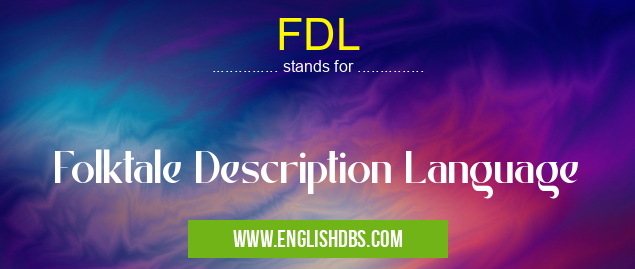What does FDL mean in LANGUAGE & LITERATURE
FDL (Folktale Description Language) is a specialized language designed to describe folktales in a structured and standardized way. It provides a framework for researchers and scholars to represent and analyze folktale data, enabling cross-cultural comparison and the study of folktale motifs and themes.

FDL meaning in Language & Literature in Academic & Science
FDL mostly used in an acronym Language & Literature in Category Academic & Science that means Folktale Description Language
Shorthand: FDL,
Full Form: Folktale Description Language
For more information of "Folktale Description Language", see the section below.
What is FDL?
FDL is a hierarchical language composed of modular components that can be combined to describe various aspects of a folktale. It consists of elements such as:
- Metadata: Information about the folktale's source, collector, and other relevant details.
- Characters: Descriptions and attributes of the characters involved in the tale.
- Events: A sequence of actions and happenings that make up the plot of the folktale.
- Motifs: Recurring patterns and themes found in folktales, such as magical objects or moral lessons.
- Structural Elements: Components that organize the folktale's narrative, such as openings, closings, and repetitions.
Benefits of Using FDL
- Standardized Representation: FDL provides a common language for describing folktales, allowing researchers from different disciplines and cultural backgrounds to share and compare data.
- Cross-Cultural Analysis: By using a standardized language, FDL facilitates the study of folktale motifs and themes across cultures, revealing similarities and differences in storytelling traditions.
- Database Management: FDL enables the creation of structured databases of folktales, making it easier to search, retrieve, and analyze data.
- Preservation and Accessibility: FDL helps preserve and make accessible folktales, ensuring that they can be studied and enjoyed by future generations.
Essential Questions and Answers on Folktale Description Language in "SCIENCE»LITERATURE"
What is Folktale Description Language (FDL)?
FDL is a standardized language specifically designed to describe folktales. It provides a structured way to capture and represent the essential elements of folktales, including plot, characters, setting, and themes.
What are the benefits of using FDL?
FDL offers several benefits:
- Consistency: It ensures that folktales are described in a consistent and standardized manner, facilitating comparisons and analysis.
- Comprehensiveness: FDL covers a wide range of folktale elements, capturing both narrative and structural information.
- Interoperability: FDL enables the exchange and sharing of folktale descriptions between different systems and researchers.
- Preservation: By providing a structured representation of folktales, FDL helps preserve and document cultural heritage.
How is FDL used in practice?
FDL is used in various applications, including:
- Folktale classification: FDL supports the automated classification and categorization of folktales based on their content and structure.
- Folktale research: FDL aids researchers in analyzing folktales, identifying patterns, and exploring cultural connections.
- Folktale dissemination: FDL enables the creation of digital folktale archives and datasets for educational and research purposes.
Is FDL a universal language for all folktales?
While FDL provides a comprehensive framework for folktale description, it is not intended to be a universal language that can capture all nuances and variations found in different folktale traditions. It is a standardized tool that aims to provide a common ground for describing and comparing folktales across cultures.
Final Words: FDL is a valuable tool for folktale researchers and scholars. It provides a structured and standardized language for describing folktales, facilitating cross-cultural analysis, database management, and the preservation and accessibility of folktale data.
FDL also stands for: |
|
| All stands for FDL |
